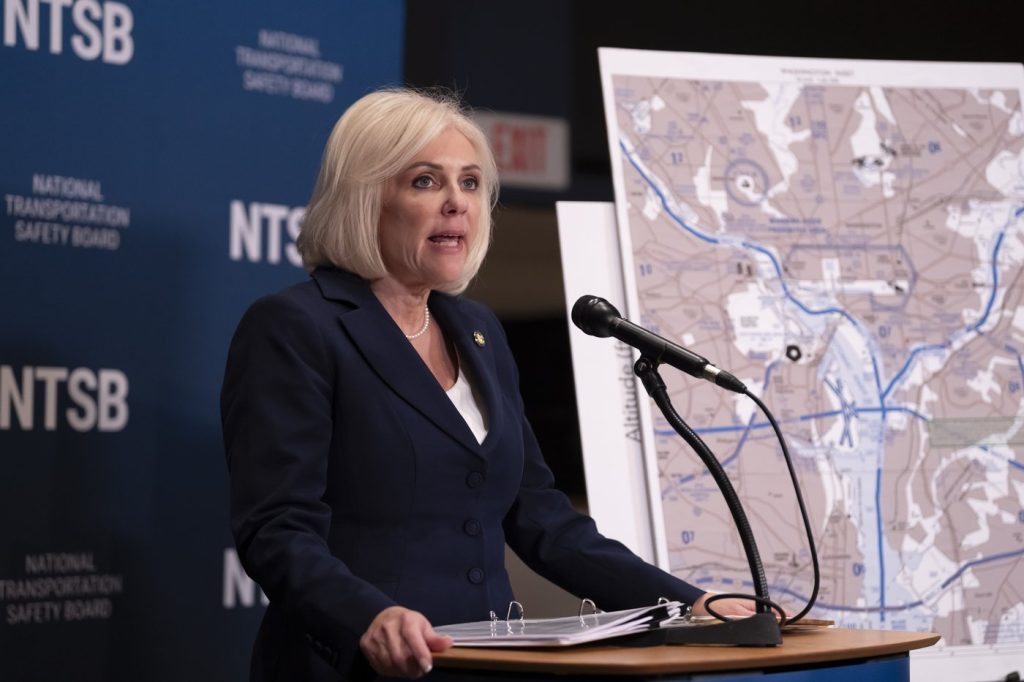On Thursday morning, Congress will conduct a hearing to investigate what is known about the deadly midair collision that occurred above Washington, D.C., killing 67 people in January. The hearing aims to uncover potential causes of the incident, where an American Airlines passenger jet collided with an Army Black Hawk helicopter as the plane was preparing to land on January 29.
In attendance will be the head of the National Transportation Safety Board (NTSB) along with leaders from the Federal Aviation Administration (FAA) and the Army's aviation division to address lawmakers' queries. Lawmakers are likely to question the NTSB's findings regarding 85 dangerous near-misses between aircraft and helicopters at Ronald Reagan National Airport over the previous three years, as well as why no preventative measures were taken. Concerns have also been raised regarding the Army's practice of operating helicopters in the area without a key safety system activated, which is designed to alert other aircraft and air traffic control about their location.
Senators Ted Cruz, a Republican from Texas, and Maria Cantwell, a Democrat from Washington, who lead the Commerce Committee overseeing aviation, have demanded answers from the Army concerning the frequency and reasoning behind their Black Hawk helicopters operating without location data transmission.
NTSB Chairwoman Jennifer Homendy described the proximity of aircraft in D.C. as an "intolerable risk to aviation safety" that the FAA should have recognized much earlier. Furthermore, she stressed the need for the FAA to better analyze its safety data, stating, "The next accident is in the data right now. And what are we doing to figure out what that is?" Transportation Secretary Sean Duffy has committed to employing artificial intelligence to analyze data from various airports to unearth any similar risks in urban areas, especially in eight metropolitan regions with busy helicopter routes such as Boston and New York City.
The investigation is in its early stages, focusing on the reasons behind the midair collision, which resulted in both aircraft plunging into the Potomac River. Unfortunately, all individuals aboard both the jet and helicopter were killed. The final report from the investigation is anticipated to take over a year to complete. Preliminary insights indicate that the helicopter may have faced inaccurate altitude readings and that the crew was potentially unable to hear crucial air traffic control instructions.
This incident marked the deadliest plane crash in the U.S. since 2001. Multiple crashes and near-misses in early 2023 have further highlighted safety concerns within the aviation industry, although air travel remains predominantly safe.
The American Airlines Flight 5342, which was coming from Wichita, Kansas, was carrying 60 passengers and four crew members. Meanwhile, the Army Black Hawk helicopter was conducting training exercises for emergency evacuations. Reports suggest that the helicopter crew was wearing night-vision goggles, potentially limiting their peripheral vision. Just before the collision, air traffic controllers had attempted to provide instructions regarding the nearing planes, but a disrupted communication may have prevented the helicopter crew from receiving all necessary directions.
Following the collision, President Donald Trump criticized the helicopter crew for allegedly flying too high and pointed toward systemic flaws in the air traffic control system, although he lacked substantial evidence to support these claims. Both aircraft had experienced prior communication issues that could have contributed to the incident.
The victims of the tragedy included the three members of the Black Hawk crew, identified as Capt. Rebecca M. Lobach, Staff Sgt. Ryan Austin O'Hara, and Chief Warrant Officer Andrew Loyd Eaves. The passenger jet included members from the Skating Club of Boston and a group of hunters, among others. These losses have prompted community tributes and fundraising efforts in their memory.










